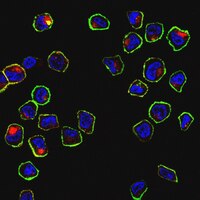MABS1916 Sigma-AldrichAnti-c-Met Antibody, clone seeMet 13
Detect Hepatocyte growth factor receptor using this mouse monoclonal Anti-c-Met, clone seeMet 13, Cat. No. MABS1916, validated for use in Flow Cytometry, Immunocytochemistry, Immunoprecipitation, and Inhibition studies.
More>> Detect Hepatocyte growth factor receptor using this mouse monoclonal Anti-c-Met, clone seeMet 13, Cat. No. MABS1916, validated for use in Flow Cytometry, Immunocytochemistry, Immunoprecipitation, and Inhibition studies. Less<<Recommended Products
Overview
| Replacement Information |
|---|
Key Spec Table
| Species Reactivity | Key Applications | Host | Format | Antibody Type |
|---|---|---|---|---|
| H | IP, ICC, FC, Inhibition | M | Purified | Monoclonal Antibody |
| References |
|---|
| Product Information | |
|---|---|
| Format | Purified |
| Presentation | Purified mouse IgG1 in PBS without preservatives. |
| Quality Level | MQ100 |
| Physicochemical Information |
|---|
| Dimensions |
|---|
| Materials Information |
|---|
| Toxicological Information |
|---|
| Safety Information according to GHS |
|---|
| Safety Information |
|---|
| Packaging Information | |
|---|---|
| Material Size | 100 µL |
| Transport Information |
|---|
| Supplemental Information |
|---|
| Specifications |
|---|
| Global Trade Item Number | |
|---|---|
| Catalogue Number | GTIN |
| MABS1916 | 04054839090233 |
Documentation
Anti-c-Met Antibody, clone seeMet 13 SDS
| Title |
|---|
Anti-c-Met Antibody, clone seeMet 13 Certificates of Analysis
| Title | Lot Number |
|---|---|
| Anti-c-Met, clone seeMet 13 - 2999490 | 2999490 |
| Anti-c-Met, clone seeMet 13 -Q2774451 | Q2774451 |
| Anti-c-Met, clone seeMet 13 Monoclonal Antibody | 3011792 |
| Anti-c-Met, clone seeMet 13 Monoclonal Antibody | 2970278 |
| Anti-c-Met, clone seeMet 13 Monoclonal Antibody | 3082509 |








